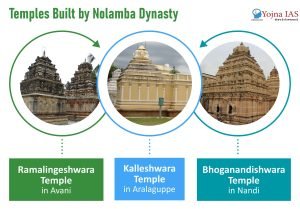30 Nov 2023 Nolamba Dynasty
This article covers “Daily Current Affairs”, and the topic details “ Nolamba Dynasty”. This topic has relevance in the History and Culture section of the UPSC CSE exam.
GS 1: History and Culture
Why in the news?
In recent historical investigations into the Nolamba Pallavas, researchers have discovered ancient inscriptions, hero stones, and depictions of Shiva Linga and Nandi idols.
The Nolamba Dynasty, often referred to as Nolamba Pallavas, played a crucial role in shaping the political landscape of South India from the 8th to the 12th centuries C.E. Unearthed artifacts, including inscriptions, hero stones, and Shiva Linga idols, provide insights into their historical significance.
Political Influence:
The Nolambas initially served as feudatories to prominent dynasties such as Pallavas, Chalukyas of Badami, Gangas, and Rashtrakutas. Later, they aligned with the Chalukyas of Kalyani. Their dominion, known as Nolambavadi, encompassed regions in southeast Karnataka, Tamil Nadu, and Andhra Pradesh.
Capital Shift:
The dynasty’s early capital was Chitradurga, but it was later relocated to Hemavati in modern Andhra Pradesh during the 8th to 10th centuries AD. This shift marked a significant era in Nolamba rule.
Founder and Origins:
Mangala Nomabathi Raja (735–785 A.D.) is recognized as the founder of the Nolamba dynasty. Inscriptions suggest that they emerged as governors during the supremacy of the Pallavas and Chalukyas. Their existence intertwined with political changes, especially after the Chalukyas lost territories to the Pallavas.
Rise and Fall:
Initially linked to the Banas and Vaidumbas, the Nolambas faced political shifts with the Chalukyas regaining control. The defeat of Pallava chiefs by the Chalukyas led to the emergence of the Nolambas. However, their decline came at the hands of Ganga king Marasimha, who claimed the title Nolambakulantaka.
Religious Legacy:
The Nolambas, devout Shaivites, left a cultural imprint through grand temple complexes dedicated to Lord Shiva. Notable examples include the Kalleshwara Temple in Aralaguppe, the Bhoganandishwara Temple in Nandi, and the Ramalingeshwara Temple in Avani.

The Nolamba Dynasty, despite its historical significance, often remains overshadowed. Through their political maneuverings, capital shifts, and religious patronage, the Nolambas left an indelible mark on South Indian history, as evidenced by the unearthed relics and temple structures that stand testament to their once-flourishing rule.
Source: Hero stones, inscriptions found in Sathya Sai district (msn.com)
Download Yojna daily current affairs eng med 30th November 2023
Q.1 Consider the following statements regarding the Nolamba Dynasty?
- The Nolambas initially served as feudatories to Chalukyas of Badami
- The Nolambas built Chennakesava temple at Belur.
Which of the statements given above is/are correct?
(a) 1 only
(b) 2 only
(c) Both 1 and 2
(d) Neither 1 nor 2
ANSWER: A
Q.2 Evaluate the role of Dravidian architecture in shaping the religious landscape and regional identity in South India.


No Comments